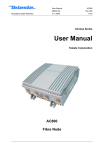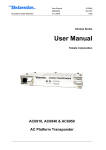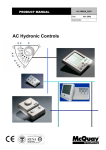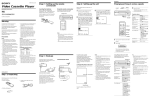Download User Manual
Transcript
Broadband Cable Networks User Manual 59300024 30.3.2007 AC8000 Rev.006 1(22) ACcess Series User Manual Teleste Corporation AC8000 Fibre Node Broadband Cable Networks User Manual 59300024 30.3.2007 AC8000 Rev.006 2(22) Introduction AC8000 is a dual active output node with high performance characteristics. The node has been designed to fulfil a variety of needs. It is extremely versatile and scalable through a wide range of plug-in options. The output amplifier stages are based on high performance hybrids, what makes the used output level range especially wide. AC8000 features two high-level distribution outputs. The second output can be divided into two outputs with a passive output module. Redundant optical input The node can be equipped with two optical receivers if redundancy of the downstream is requested. In the event of fibre break, the platform provides manual or automatic switchover between alternative fibre paths. Return path redundancy or segmentation The upstream channel can also be fully redundant with double transmitter solution. If more return path segmentation is requested both optical return transmitters can be fed by separate return signals. Redundant or segmented upstream operation is selected with the return module. Redundant powering Up to two power supplies can be installed in the node. Two field replaceable housing lids preinstalled with power supply units are available for easy and fast installation, AC6311 with one power supply and AC6312 with two power supplies. The field replaceable housing lids are shipped completely including the connection cable and mounting materials. Equipped with dual power supplies, the AC8000 platform offers complete system redundancy. Transponder AC8000 nodes can be remotely monitored and controlled via the plug-in transponder unit. Locally the transponder unit can communicate with a lap top computer or hand-held terminal. With this transponder unit it is possible to monitor received optical level, transmitter’s laser current, remote voltage, both power supply output voltages, internal temperature and lid status. Furthermore the transponder is able to control the backup switching, return path transmitter as well as return path ingress switches. Automatic Level Control Platform features also an automatic microprocessor controlled output level control (ALC). The ALC function allows monitoring and control of a large number of parameters in the nodes, optimizing the performance of the platform. WEEE Notice This product complies with the relevant clauses of the European Directive 2002/96/EC on Waste Electrical and Electronic Equipment (WEEE). The unit must be recycled or discarded according to applicable local and national regulations. European Conformity This equipment conforms to all applicaple regulations and directives of European Union which concern it and has gone through relevant conformity assessment procedures. Broadband Cable Networks User Manual 59300024 30.3.2007 AC8000 Rev.006 3(22) Housing 8604043 Fig. 1. AC8000 housing dimensions – top and side view Installation The AC8000 can be installed either into a street cabinet or to the outdoor environment. The node should be installed in a vertical position so that the external cable connectors are underneath. Secure the housing with three mounting brackets – see fig. 1 for the positions of mounting brackets as well as other installation dimensions. The cover opens with the hinges to the left. The open cover can be removed by first opening the cover into a 90 degrees angle and the lifting it off the hinges. Note! Before removing the cover detach carefully the power unit ribbon cable. Close the lid by tightening the four retaining bolts in a diagonal sequence. Before closing the lid check that • nothing is trapped between the lid and the case • all case gaskets are in their correct positions A sufficient tightening torque is 3 Nm. Ensure that the lid seats evenly on the rubber gasket. The class of enclosure is IP54. To ground the node housing connect at least 4 mm2 grounding wire (Cu) from a proper earth to the grounding point. User Manual 59300024 30.3.2007 Broadband Cable Networks AC8000 Rev.006 4(22) Cable connections 8604050 Grounding point Fibre input port Output port 3 Output port 2 Output port 1 Fig. 2. Port locations The AC8000 fibre node has four dedicated cable connection points: one fibre input and two/three RF outputs. The amount and function of the actual connectors varies with the chosen configuration. All coaxial outputs have a standard PG11 thread and they accept any KDC type adapter or connector. A suitable length of the coaxial cable inner conductor exposed for the connectors is approximately 20 mm (Fig. 3). 8604025 Fig. 3. Centre conductor length User Manual 59300024 30.3.2007 Broadband Cable Networks AC8000 Rev.006 5(22) Fibre connections The node can accept four fibre cables. These cables carry forward path and return path optical signals. When feeding the optical cable in the node, a suitable PG11 threaded feed-through adapter type KDO900, is available. Remove the outer ring of the cable gland, thread the installation fibre filaments with connectors through the outer ring (Fig. 4 pos. 3), through the sealing insert (Fig. 4 pos. 2) and finally through the cable gland (Fig. 4 pos. 1). Mount the cable gland on the housing. The fibre filament length inside the fibre organiser is adjusted to sufficient measurement before tightening the outer ring. Use the synthetic locking pins (supplied) to seal up unused holes in the sealing insert. 8606022 1 2 3 Fig. 4. KDO900 adapter components Fibre installation Fibre installation is a critical procedure and it should be done with carefulness. Incorrect handling of the fibre can result in damage and degraded performance. Example of routing the fibres can be seen in figure 8. Cleaning fibre connectors • For correct optical operation ensure that all optical connectors are cleaned immediately before mating using a suitable optical connector cleaning kit. • If a cleaning kit is not available, wipe the end of the connector using pure isopropyl alcohol (99%) and a lint-free wipe. Dry it with filtered compressed air. Wait until dry to insert connector into the adapter. • When fibre optic connectors are unmated, the optical fibre end faces must be protected from contamination using suitable dust caps. Contamination of fibre end faces will reduce the performance of the optical fibre and could ultimately cause failure of the system. Contamination could also damage the fibre end faces when the connectors are mated. DANGER! Do not look into the optical connector of the return transmitter with power applied. Laser light, visible or invisible, can seriously injure eyes or even cause blindness. User Manual 59300024 30.3.2007 Broadband Cable Networks AC8000 Rev.006 6(22) Powering The AC6310 is a power supply unit (PSU) to be used in AC8000 lid mechanics. The node is supplied with 27...65 V AC or 35...90 V DC either via a coaxial cable or directly at the external input. The external input is located on the power distribution board at the upper right corner of the amplifier (Fig. 5). External power can also be fed through the amplifier into the network. Maximum feedthrough current is 10 A per port (15 A total). If powering will be provided through a dedicated output port, the port must be equipped with a fuse (supplied). In general only one power supply is needed in the node. However the power supply unit can work alone or in dual-operation mode if a back-up of the PSU is needed. In dual powering operation the units are connected in parallel operating in a passive load sharing mode. The output voltages can be monitored through the EMT module. The power supply unit also has an auto shut down feature, which prevents too high input currents if the input voltage should drop below 24 V AC. The external alarm connector on the power distribution board (Fig. 5) can be configured to allow input of one external alarm to be monitored with the EMT module. When external alarm is enabled with the jumper the alarm will be displayed instead of the PSU2 alarm. Table 1 shows the correct jumper configurations. The external alarm input is normally connected to a switch. An alarm is activated when the switch is closed. Whenever external alarm is enabled verify that the low voltage alarm on PSU2 is set at 23.0 V. Alarm voltage at a switch closure is typically 18 V…19 V. Refer to the user manual of “AC6910, AC6940, AC6950 AC PLATFORM TRANSPONDER” for details. Note! If PSU2 is in use and external alarm is enabled, the only way to confirm proper operation of the PSU2 is visually check the LED on the PSU circuit board. ribbon cable clamp 8604100 ribbon cable header external alarm connector alarm jumper alarm switch OPEN = no alarm CLOSED = alarm Fig. 5. Alarm jumper on the power distribution board Alarm connected to EMT module Jumper position PSU2 alarm (default) External alarm Table. 1. Alarm jumper configurations Broadband Cable Networks User Manual 59300024 30.3.2007 AC8000 Rev.006 7(22) Installing the PSU To gain access to PSU retaining screws, first remove the protective shroud. The shroud is attached to the lid, to shield the electronics from electromagnetic interference. Install the PSU board with the four M3x8 mm torx screws. Use the silicon elastomers between the unit and the heatsink brackets. Make sure to use the fixing springs in the locations marked with B (Fig. 6). ac8k_power_b Fig. 6. AC6310 mounting screws (A), fixing springs (B) and silicon elastomers (C) Primary and secondary power supplies are physically identical. Their functional differences are controlled by a jumper. See fig. 7 for locations of the jumper pins. The jumper must be positioned prior to installation. The primary power supply unit must be installed into the first place (closest to the hinges). Locate the 10-pin connectors and attach the supplied ribbon cable. After PSU installation carefully refit the shroud in the reverse order of removal. Ensure that all RFI gaskets are in place before the shroud is refitted. Broadband Cable Networks User Manual 59300024 30.3.2007 AC8000 Rev.006 8(22) Before connecting the power make sure that • both power supplies are installed in correct positions • jumpers is set correctly (Fig. 7) Connect the power source. The LED on the PSU circuit board indicates that the unit is powered up and that the DC power supply voltage is present. 8603052 PSU2: Make sure the jumper is on the right-hand location. PSU1: Make sure the jumper is on the left-hand location. Fig. 7. Diagram illustrating the AC8000 lid with both PSUs installed. Broadband Cable Networks User Manual 59300024 30.3.2007 AC8000 Rev.006 9(22) Fibre organiser mechanics The node is equipped with a double sided fibre organiser module. It is meant to be the installation chassis for the fibre pigtails (Access units) and installation fibre filaments (external fibre optic cables). 8604076 Fig. 8. AC8000 fibre organiser module Fitting of the fibres under the retaining tabs is designed to keep the fibres in place without the use of cable ties. The fibre organizer is equipped with lids to ensure fibre protection. The lids provide easy and fast re-entry by using plastic clips. 8605016 Fig. 9. AC8000 fibre organizer Broadband Cable Networks User Manual 59300024 30.3.2007 AC8000 Rev.006 10(22) Carefully wind the fibres around the fibre tray noting the entry points for the installation fibre filaments (Fig. 10 pos. A) and the fibre pigtail of the optical receiver1 (Fig. 10 pos. C). Each fibre should be connected to its corresponding adapter (Fig. 10 pos. D). The fibre organiser tray is equipped with slots (Fig. 10 pos. B) for fibres to be routed on either side of the fibre tray. The under side of the fibre tray is reserved for fibre pigtails of return units and the upper side for fibre pigtails of forward units. 8604084 Fig. 10. Routing fibres – typical configuration Where fibres pass the bending point of the fibre organiser module, there must not be any strain on attachments or excessive slack when it is opened or closed. Therefore the pigtail of the optical receiver 1 must be routed above all other fibres – refer to fig. 10. User Manual 59300024 30.3.2007 Broadband Cable Networks AC8000 Rev.006 11(22) Connectors and plug-in slots 58700174 12 11 3 16 4 4 receiver 1 receiver 2 equaliser attenuator attenuator 14 15 OMI TP TX 2 13 6 58700174 OMI TP TX 1 2 diplex filter return module diplex filter 5 1 receiver 1 receiver 2 transmitter 1 5 transmitter 2 output splitter 17 fuse fuse fuse output 3 10 TP / test injection -20 dB 17 output 2 8 TP / test injection -20 dB 6 output 1 9 17 Fig. 11. AC8000 plug-in placement, 1) 2) 3) 4) 5) 6) 7) 8) Optical receiver 1 Optical receiver 2 (backup) Interstage equaliser Interstage attenuator(s) Diplex filter(s) Output test point(s) / Test signal injection point(s), -20 db directional coupler Output 1 Output module (see table 2) 9) 10) 11) 12) 13) 14) 15) 16) 17) Output 2 Output 3 Slot for element transponder module Return module Slot for optical transmitter 1 Slot for optical transmitter 2 OMI test point for optical transmitter 1 OMI test point for optical transmitter 2 Fuse(s) 7 Broadband Cable Networks User Manual 59300024 30.3.2007 AC8000 Rev.006 12(22) Forward path / Optical receivers The AC6810/20 is a line of fibre optic receiver modules used in the AC8000 node platform. Its performance and the features have been designed for the fibre to the curb and the fibre to the building (FTTC/ FTTB) applications. Depending on the optical input power, there are two kinds of modules available • AC6810 with an optical input power range ranging from -7 dBm to -2 dBm • AC6820 with an optical input power range ranging from -3 dBm to +2 dBm It is possible to order the AC8000 platform with only one optical receiver installed and add a second receiver for backup reasons later. If two optical receivers are used the primary signal must always be connected to optical receiver 1 since it is always in use even if the transponder is not installed. The transponder is able to switch automatically the transmission to the secondary fibre route in a case of primary route failure. The output stage uses a GaAs hybrid to improve RF performance over the entire 47 to 862 MHz passband. A diplex filter is selected during configuration according to the preferred frequency split. The second output port, through the use of plug-in output modules, can be set up for a variety of output configurations. Refer to the ‘Table 2.’ Output modules’. Output module Description AC6112 1/12 dB tap AC6116 1/16 dB tap AC6119 1/20 dB tap AC6120 0 dB output module AC6124 Two-way splitter AC6128 2/9 dB tap Table. 2. Output modules Gain control The optical receiver module is delivered without an attenuator plug. If necessary use an attenuator plug-in to get appropriate RF level. Attenuators of the JDA900 series type ranging from 0 dB to 20 dB in 1 dB steps are available. The attenuator value depends not only on the optical input level but also on the optical receiver type and the OMI. Refer to the ‘Table 3. Receiver attenuator selection guide’. Broadband Cable Networks User Manual 59300024 30.3.2007 AC8000 Rev.006 13(22) Optical input power Optical input power can be measured with optical power meter or at the receiver DC test point. The test point DC voltage is directly proportional to optical input power in mW e.g. 1.0 V corresponds to 1.0 mW average optical power. In case of a 1310 nm wavelength selection the input power in dBm (W) can be calculated by the formula Pin (dBm)=10*log (UTP). When using 1550 nm transmitters the input power is 0.5 dB lower than this formula indicates. Do not connect any voltage to the test point or short circuit it to ground. Use a voltage meter with an input resistance higher than 100 kohms. The LED on the receiver’s front panel gives a visual indication of the optical input power. LED on AC6810 Condition Yellow Optical input power drops below -10.0 dBm Green Optical input power is within the nominal range (-10.0…3.0 dBm) Red Optical input power exceeds 3.0 dBm LED on AC6820 Condition Yellow Optical input power drops below -4.5 dBm Green Red Optical input power is within the nominal range (-4.5…3.0 dBm) Optical input power exceeds 3.0 dBm The user can specify all the limits for the LED indication of the optical input power with the transponder unit. Therefore the above mentioned limits are valid only if the transponder unit is not installed. Broadband Cable Networks User Manual 59300024 30.3.2007 AC8000 Rev.006 14(22) Element management transponder Some of the parameters can be controlled and monitored through the transponder interface. The transponder unit will automatically detect the current configuration of the Access platform when the user opens the “Configuration” page. The “Configuration” page displays a graphical view of the current configuration similar to the actual amplifier/node layout and also generates a set of viewer pages individual to each active device. It is important to start a configuration session by selecting first the “Configuration” page since it is the only way to generate the module specific viewer pages. Fig. 12. The Optical page This page is visible in AC8000 platform only. It displays data and settings of the optical transmitter and receiver modules and controls their connection. Input selection These settings provide manual or automatic switchover between two input channels in case the incoming signal is lost. There are four possible selections. When the input selection is set to the “Automatic” mode, the node automatically selects the input channel according the signal conditions. If the signal level at the main input is below the low alarm limit or over the high alarm limit, the backup input will be selected. The main input is selected when the signal level is between limits. This fully automatic input selection between the two inputs offers a useful redundancy mode for critical applications. When the input selection is set to the “Automatic (manual restore)” mode, the automatic input selection takes place in the same way as before but user has to reset the switch back to the main input by manually selecting ”Manual: Rx #1” and after that ”Automatic (manual restore)” again. The input selection mode can also be set to manual mode where the user can override the automatic procedures. In “Manual: RX #1” mode the main input is used. In “Manual: RX #2” mode, the backup input is used. There might be a slight delay between the input selection and the reply of the optical node. Broadband Cable Networks User Manual 59300024 30.3.2007 AC8000 Rev.006 15(22) Return transmitters When the “Return transmitters” selection is set to the “Both transmitters on” mode, both transmitters are forced to be active regardless of the input selection. In the “One transmitter on” mode, only one transmitter will be active and it will automatically follow the active receiver (i.e. the node supports continuous operation of one transmitter with the input selection control). Receiver modules The types of the receiver modules as well as the measured optical input levels are displayed in the “Receiver modules” frame. The background colour of the “Optical level” data field changes to indicate alarms. A green background means acceptable values and red is the symbol for an alarm. The “Active” radio button indicates which of the receiver modules is in use. The frame also displays the “Optical level limits”. The main input limits are also used to control the automatic input selection. All the limits are set by the manufacturer and can be modified with an “End User” user profile or higher. The deadband limits can only be modified by users with a “Service” level user profile or higher. Transmitter modules The types of the transmitter modules as well as the measured laser currents are displayed in the “Transmitter modules” frame. The background colour of the “Laser current” data field changes to indicate alarms and warnings. A green background means legal values; yellow is the symbol for a warning. The frame also displays the “Laser current limits” after which the unit starts indicating alarms and warnings. All the limits are set by the manufacturer and are displayed as read-only information. The “Transmitter modules” frame includes also a “Pilot” check box that, when selected, enables the pilot signal. The pilot signal frequency (4.5 MHz or 6.5 MHz) can be selected with a DIP switch on the transmitter module’s front panel. User Manual 59300024 30.3.2007 Broadband Cable Networks AC8000 Rev.006 16(22) Node control unit ac6183 AC6183 Node control unit Optical RX 1 auto 2 Gain 2 Gain 1 Return Path Control 0 dB -6 dB -50 dB 2 1 Fig. 13. AC6183 front panel The AC6183 node control module provides manual control of gain, input redundancy functions and ingress switch. The AC6183 front panel contains three 3-pos, vertical toggle switches and two screwdriver adjustable potentiometers. Optical RX These settings provide manual or automatic switchover between two input channels in case the incoming signal is lost. If the ‘Auto’ mode is selected, the unit will look for an optical signal on the inputs to select the active input. If the second input becomes active, the unit will automatically change to the new input. The input selection mode can also be set to manual mode where the user can override the automatic procedure. In position ‘1’ the main input is selected as primary input path. In position ‘2’ the backup input is selected as primary input path. Gain The gain adjustment is based on either AC6173 or AC6174 electrical adjustment board. The output level adjustment range with AC6173 is 0…-10 dB with -1 dB feed through loss. The output level adjustment range with AC6174 is 0…-13 dB with -2.5 dB feed through loss. See the ‘Electrical adjustment module’ chapter for more details. Return Path Control Controls the attenuation of the ingress control switches. The return path signal can either be cut off (i.e. signal is attenuated more than 50 dB) or be attenuated by 6 dB. As default factory setting the ingress switch is set to 0 dB position. Broadband Cable Networks User Manual 59300024 30.3.2007 AC8000 Rev.006 17(22) Electrical adjustment module AC8000 node can also be outfitted with electrical adjustment board (AC6173 or AC6174), which enable fine adjustment of the input levels. This module is driven either by the transponder unit or manual node control unit. An electrical adjustment module is placed in the plug-in position for interstage attenuators (Fig. 11 pos. 4). Although the modules are placed in the plug-in position for interstage attenuators, installation is only possible after the removal of the shielding cover. Refer to fig. 14 for locations of the electrical adjustment boards. ALC The node features an ALC function which ensures that the output level is constant even if the optical input level is varying. In order to utilize the ALC function a transponder (AC6950 or AC6940) is needed. ac6173kp Fig. 14. Electrical adjustment module (AC6173) Broadband Cable Networks User Manual 59300024 30.3.2007 AC8000 Rev.006 18(22) Forward path adjustments The following are instructions to be used for a normal adjustment procedure. This procedure assumes that the output module and diplexers that are specified in the network plan are installed. 1. Do not connect fibres or apply power before all the adjustments described below have been made. 2. Use an optical power meter to measure the level of the optical input signal(s) 3. Install an attenuator in the optical receiver to get appropriate RF level. Attenuators of the JDA900 series ranging from 0 dB to 20 dB in 1 dB steps are available. The attenuator value depends not only on the optical input level but also on the optical receiver type and the OMI. Refer to the table 3. Opt. input level (dBm) 2 1.5 1 0.5 0 - 0.5 -1 - 1.5 -2 - 2.5 -3 -3.5 -4 -4.5 -5 -5.5 -6 -6.5 -7 Attenuator (4% OMI) AC6810 AC6820 JDA910 JDA909 JDA908 JDA907 JDA906 JDA905 JDA904 JDA905 JDA910 JDA902 JDA909 JDA901 JDA908 JDA900 JDA907 JDA906 JDA905 JDA904 JDA903 JDA902 JDA901 JDA900 - Attenuator (5% OMI) AC6810 AC6820 JDA912 JDA911 JDA910 JDA909 JDA908 JDA907 JDA906 JDA905 JDA912 JDA904 JDA911 JDA903 JDA910 JDA902 JD909 JDA908 JDA907 JDA906 JDA905 JDA904 JDA903 JDA902 - Table 3. Receiver attenuator selection guide User Manual 59300024 30.3.2007 Broadband Cable Networks AC8000 Rev.006 19(22) 4. Choose the interstage attenuators (Fig. 11 pos. 4) for both outputs according to wanted output level. The network plan should specify exact signal levels. Refer to the table 4. If the node has currently electrical level adjustment modules (AC6173) installed, skip to step 5. Output level (dBμV) 108 107 106 105 104 … Interstage attenuator (dB) JDA900 JDA901 JDA902 JDA903 JDA904 … Table 4. Interstage attenuator selection guide 5. Install the interstage equaliser (Fig. 11 pos. 3) according to network plan. 6. Apply the power. 7. Connect the fibre(s). 8. The optical receiver may need fine tuning at this point. To fine tune use the interstage attenuator (Fig. 11 pos. 4) to set the output level equal to your reference. If electrical level adjustment modules (AC6173) are used, adjust the gain control to achieve the desired output level. The adjustment range is 107…97 dBμV. Before the fine tune, allow the unit to reach its normal operating temperature (approx. 10 min). User Manual 59300024 30.3.2007 Broadband Cable Networks AC8000 Rev.006 20(22) Return path / Optical return transmitters Optional return path operation requires plug-in diplex filters (Fig. 11 pos. 5), return path module (Fig. 11 pos. 12) and optical return transmitters (Fig. 11 pos.13, 14). The available diplex filter types are CXF030 (30/47 MHz), CXF042 (42/54 MHz), CXF050 (50/70 MHz) and CXF065 (65/85 MHz). It is also possible to order the node with no diplexers, in which case the diplex filters are replaced by forward path jumpers CXF000. The return path can be configured with a return path module. A return path split module can be used to provide return path segmentation whereas a return path combiner module is used to provide signal redundancy. There is a variety of return transmitters available for the Access platform (Table 5). It is also possible to order the AC8000 platform with only one optical transmitter installed and add a second transmitter for backup or segmentation reasons later. To take the return path into use, one of these optical return transmitters must be installed. Type AC6830 AC6835 AC6840 AC6845 AC6847 AC6849 AC6851 AC6853 AC6855 AC6857 AC6859 AC6861 Description FP, 1310 nm, -7 dBm FP, 1310 nm, -3 dBm FP, 1310 nm, +1 dBm DFP, 1310 nm, +3 dBm CWDM, 1470 nm, +3 dBm CWDM, 1490 nm, +3 dBm CWDM, 1510 nm, +3 dBm CWDM, 1530 nm, +3 dBm CWDM, 1550 nm, +3 dBm CWDM, 1570 nm, +3 dBm CWDM, 1590 nm, +3 dBm CWDM, 1610 nm, +3 dBm Table 5. Optical return transmitters Gain control Set driving level for the laser by installing appropriate attenuator in the transmitter. Attenuators of the JDA900 series type ranging from 0 dB to 20 dB in 1 dB steps are available. The front panel label (Fig. 15) describes the drive level corresponding to 4% OMI / channel. Pilot The pilot generator level corresponds to 4% OMI. Available pilot signal frequency 4.5 MHz or 6.5 MHz can be controlled with a DIP switch on the module’s front panel (Fig. 15). Note: Transponder will always control pilot ON/OFF regardless the DIP switch’s state. User Manual 59300024 30.3.2007 Broadband Cable Networks AC8000 Rev.006 21(22) 8607020 DIP Switch Setting LEFT RIGHT 1 2 4.5 MHz ON OFF 3 6.5 PILOT Switch 1 – Pilot Signal Frequency Left Right Selects 6.5 Mhz Selects 4.5 MHz Switch 2 – Level of Output Power AC6861 + 3 dBm 1610 nm AC68 Tx Selects nominal +1 dBm Selects 0 dBm Switch 3 – Pilot Signal Status Selects ON Select OFF Fig. 15. AC68 Tx DIP switch positions. Laser With the DIP switch it is possible to reduce nominal optical power by 1 dB. But OMI is also changed. However the product specifications are valid only when using the nominal power. In 0 dB position use 2 dB lower drive level. User Manual 59300024 30.3.2007 Broadband Cable Networks AC8000 Rev.006 22(22) Return path adjustment Inject a signal of known power (20 dB higher compared to return path input level) into the test signal injection point (Fig. 11 pos. 6) in the node. The level of return signal can be measured from the optical transmitter’s OMI test point (Fig. 11 pos. 15 or 16). In the front panel label of the return transmitter is described the driving level at the OMI test point that gives 4% OMI / channel. The return signal level should be adjusted to match this level, which is specific for each unit. For other OMI values, the needed adjustment setting can be calculated from the formula: 20 x log (new OMI% / 4%) Depending on the nature of the return signal, the input level can be measured as follows: • When using a reference or test signal, the level of the carrier signal is measured from the test point and it is adjusted to a value shown in the unit’s label or calculated from it. • When using a digital, noise like signal, the spectrum analyser’s noise marker is adjusted to the same bandwidth as the digital signal has and the level is adjusted to the value shown in the unit’s label or calculated from it. Utilising remotely controlled ingress switch allows the operator to isolate problems in return path and take corrective actions. The return path signal can either be cut off (i.e. signal is attenuated more than 45 dB) or be attenuated by 6 dB. As default factory setting the ingress switch is set to 0 dB position. Since homes may not always be connected to return path services, the return path RF signal should be cut off by the management unit. Once connected, the ingress switch should be set to 0 dB position.

































